 Introduction
Introduction
A Danish farming newspaper has caused quite a stir by devoting a sizeable part of its 13 April edition to the discoveries by pig farmer lb Borup Pedersen that GM soy has a damaging effect both on his animals and on his farming profitability. On the front page of the paper there was a lead story under the headline "Pig farmer reaps gains from GMO-free soy". On a sidebar the paper referred to Mr Pedersen's contention that DDT and Thalidomide were minor problems when set alongside GMOs and Glyphosate. In an Editorial Comment on page 2, the paper argued that it would be grossly irresponsible for the authorities to ignore or ridicule the discoveries made by the farmer in his pig farming operations, and it congratulated the authorities for commissioning a new study designed to determine whether stomach lesions and other effects might be associated with GM soy; in the study 100 animals will be fed with non-GM soy and 100 with GM soy in their diets.
On pages 6 and 7 of the paper there was a big article written by Anne Wolfenberg, who is a very experienced journalist who knows the Danish pig farming industry well. This article was leaked in draft form, translated into English and widely circulated, appearing on various web sites. GM-Free Cymru helped with that translation, in the belief that this was the final published version and that the farmer, the writer and the newspaper would be happy to see it circulated to an English-speaking readership. Full acknowledgement and citation were made. However, we did not realise that there were one or two small errors in the draft which were corrected in the final printed version; and partly on that basis we received a complaint from the author. We apologised for the misunderstanding, and the article was immediately removed from the GM Watch web site. We also asked an American web site which had used the article to take it down, in line with the journalist's wishes. This was also done.
In deference to the concerns of Anne Wolfenberg, we are not including any translation of her article here. Instead, we have spoken to Mr Pedersen, and he has kindly given us permission to use content from his Powerpoint presentation, to use direct statements made by him, and to use his photographs. On that basis we have assembled the first part of this dossier.
In the second part of the dossier, we examine the key points arising from the coverage of this issue in the Danish farming newspaper Effektivt Landbrug. We congratulate the editor and the journalists involved on a very effective and well-researched piece of investigative journalism, and for having the courage to publish it in spite of the anger it was bound to provoke! We also congratulate Mr lb Pedersen for his very careful record keeping and for making the decision to place it in the public domain, in the public interest.
In the third part of this dossier we have translated a press release relating to the new Danish research project which will examine the effects of GM soy on pigs during the period of weight gain from 30 kg to slaughter at c 110 kg. While we applaud the fact that this research will be conducted, we are concerned that the feeding of the weaned animals from 7 kg (28 days) up to the 30 kg weight will potentially mask GM effects and compromise the results. As the newspaper suggests, it will be in nobody's best interests if these trials are mistrusted or later found to be fraudulent. Dr Brian John from GM-Free Cymru agrees, and says: "We have been involved in GM issues for more than a decade, and we know the score. We can take it as read that there are large sections of the GM industry, and maybe large parts of the farming community, especially in the United States, who will move heaven and earth to prevent anything damaging to the GM cause from seeing the light of day. We suspect that huge pressure has already been put on the Danish journalist and her newspaper by certain interested parties, including farming unions, agrichemical companies and so forth. That is plain stupid of them; their interests are served least of all if real animal welfare and food safety issues are brushed under the carpet."
In the fourth part of the dossier we report on an interview with another Danish farmer whose experiences relating to a shift from GM soy animal feed to non-GM soy feed appear to match very closely the experiences of Mr Pedersen.
Part 1. The Pilegaarden Findings
Animal Health and Welfare
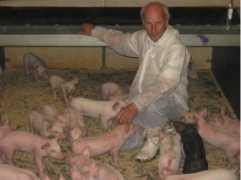 When Danish pig farmer lb Borup Pedersen replaced GM soy with non-GM soy in the feeding schedules on his farm, he immediately observed positive changes in the health of the sow herd. He has spoken to a mainstream Danish farming newspaper (Effektivt Landbrug) about this, and the editor has devoted much space to the issue – presumably on the basis that Mr Pedersen is not an organic farmer, but a regular farmer using the same intensive techniques to raise pigs as many other farmers across the country. He farms at Pilegaarden, Hvidsten, near Randers on Jylland.
When Danish pig farmer lb Borup Pedersen replaced GM soy with non-GM soy in the feeding schedules on his farm, he immediately observed positive changes in the health of the sow herd. He has spoken to a mainstream Danish farming newspaper (Effektivt Landbrug) about this, and the editor has devoted much space to the issue – presumably on the basis that Mr Pedersen is not an organic farmer, but a regular farmer using the same intensive techniques to raise pigs as many other farmers across the country. He farms at Pilegaarden, Hvidsten, near Randers on Jylland.
Danish pig production is recognised worldwide for having a the highest level of productivity, with an average of almost 30 weaned pigs per sow per year. Combined with the an antibiotic use of less than 50 mg per kg of produced pork (most other countries except the other Scandinavian states use 2-4 times that amount), that makes them the unofficial "world champions" of swine production. The fact that all use of antibiotics is recorded and strictly controlled by veterinary officers makes statements from the Danish farmer strong, and both field trials and scientific trials made in Denmark are widely accepted all over the world. Research facilities in Denmark are controlled by the farmers themselves or they are governmental, which means the influence of the GMO industry is far less than in many other countries.
In his discussions with GM-Free Cymru Mr Pedersen itemised the following effects:
- Within 2 days diarrhoea virtually disappeared in the farrowing house, whereas before we had used 50-100 ml Borgal / day.
- Since switching, we have not experienced death from bloat in sows or death by ulcers, as opposed to minimum 1 per month previously. (36 sows died due to stomach related sickness over the last two years before switching)
- No sows have died through loss of appetite, whereas 2 sows died from this cause last year.
- Even without washing between farrowings, diarrhoea does not now reappear. Previously when we failed to wash between sows, we noticed more diarrhoea.
- Previously we have struggled with diarrhoea in first layer sows, we do not have this problem any more!
- Two years ago when the diarrhoea was as its worst, we had months with nearly 30% dead in the farrowing house. At that time it was impossible to find sows that could nurse piglets.
- Before it was unusual to have a sow with 13 piglets weaned. The average was about 10.5 per sow plus spare mothers. Now we are getting over 12 piglets on average weaned and 14 piglets weaned per sow is common. We have fewer nursing sows, simply because the sows are milking better and eating more.
- Sows farrow better and we have 0.3 more live births per sow, of which 0.2 is gained from fewer stillborn. Now we have 14.9 liveborn and 1.6 stillborn, averaged over the past 7 months.
- The piglets weaned are stronger and more evenly sized.
- Man-hours are reduced by 20-30 hours per month, partly by washing less and because everything is easier.
"We switched to fishmeal and non-GMO soya in the weaning house, instead of GMO HP 200 (purified GMO soya) and GMO soya. The piglets seem more active. We have only fed them on this for three months, so there is no secure data. From 15 Kg we have just stopped using GMO soya; we are still not certain about cause and effect, but medicine usage already appears to have fallen to near half of what it was."
Mr Pedersen says: "I have been looking after my 450 sows with the same worker for 5 years, and our management of the animals is unchanged. That is clearly not the reason for our improved results. When I switched to non-GMO soy in April 2011,1 chose not to tell my employee, but he was nevertheless quick to notice a difference. "You've changed the diet," he said to me a few days after the switch to GM-free soya feed. "Well, what's wrong now?" I asked, but it turned out that for the first time in many months there had not been any animals needing to be injected with Borgal against piglet diarrhoea. The positive trend has remained ever since and has indeed been further enhanced over the last year. Just the savings I have accomplished in medicine expenses have paid for the extra cost of the GMO-free soy."
Deformed and Stillborn Piglets
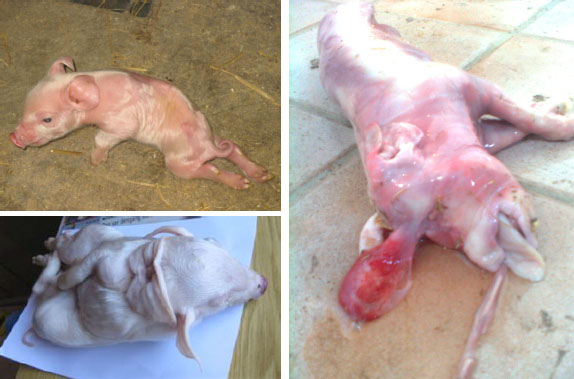 Above right: Piglet with a cranial deformity. Above left: Piglet with a spinal deformity. Below: Siamese twin piglets
Above right: Piglet with a cranial deformity. Above left: Piglet with a spinal deformity. Below: Siamese twin piglets
For whatever reason, dead and deformed piglets are a problem in all pig farming situations where GM soy is used in the diet. Mr Pedersen is convinced that this is connected to the residues of glyphosate that are allowed in feed within the EU – 20 ppm in corn and soybean. He says that residues have been measured at 17 ppm in soybean meal, and that the permitted level of tolerance has been fixed at the behest of the GM industry. In Argentina, he says, farmers typically spray 4 litres of Roundup in growing 1 tonne of GM soybeans. GMO crops are typically sprayed 2 times with Roundup in the growing season. Argentina is a major supplier of GM soy into the European market. He says: "When growers in Denmark dry out cereals and oilseed rape, the content of glyphosate in the harvested crop is quite high, since spraying takes place just 10-14 days before harvest. You know that 80% of the glyphosate remains in the plant; some is degraded and the rest stays in the plant and condenses in the growing points, which are at that stage the seeds."
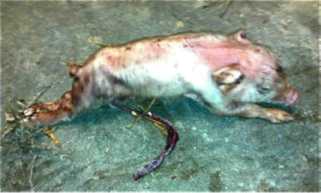 Piglet with a spinal deformity
Piglet with a spinal deformity
He says: "In my grain silo 15% of the grain is dried out with Roundup and I buy barley for the sows, so 40% of the feed could be sprayed with Roundup. From my study of the literature, it appears that malformations in foetuses in certain animal species start at 0.2 ppm, and that endocrine disruption starts in humans at concentrations of 0.5 ppm. Total death of human cells occurs at 10 ppm. We have had 13 malformed piglets (about one in 700) born over the last nine months, most of them liveborn. We know from experiments that glyphosate damages the cranium and spine in approximately 70% of test animals. I am convinced that Roundup causes serious birth defects especially of the head and spine in foetuses of both humans and animals." He cites information from Argentina concerning the effects on human beings of glyphosate / Roundup spraying in rural areas affected by spray drift. Some of his pigs had the same type of damage as the children in this YouTube film: http://www.youtube.com/watch?v=mqXId_-dTbw
Mr Pedersen adds: "Independent researchers have shown Roundup to be both a powerful and non-selective biocide and an endocrine disruptor, leading to birth deformities, abortion, cancer and changes in microflora in the gut of mammals, so that Clostridia becomes a problem. This, I think, is the direct reason for chronic botulism in cattle. I know that the diarrhoea and bloated sow problems which we had – and which disappeared with the changed diet – were due to Clostridia bacteria."
Looking to the future, he says: "I am sure that Danish farmers would stop using GM soy in the feed for their animals if they knew the harmful effects it is having on animals and humans. I believe that the effects of DDT and Thalidomide can be described as trivial compared to the effects we are now seeing from the use of GMO crops that are sprayed with Roundup. Those negative human health effects will greatly increase in the future as Roundup consumption increases worldwide. I dread to think how serious the situation might become before the world community calls a halt to this dependence on a harmful animal feed supply contaminated with herbicides." He cites researchers who urge the application of the the precautionary principle and who call for Roundup to be phased out.
Finally he quotes from Professor Don Huber: "We will not in future be remembered for being the generation that shed so many tons of chemicals on our fields, but as the generation who willingly sacrificed our children for a few multinational companies' profits."
Economic Realities
Mr Pedersen has analysed the effects of converting to the use of non-GM soy in his farrowing house, and is convinced that his actions have resulted in increased farm profitability. This is how he assesses the situation: "We find that efficiency – measured in terms of man-hours required in the shed – is rising, since the animals are more contented and more healthy. Now we have 1.8 more piglets weaned per sow – 29.9 as opposed to 28.1 before the change to non-GM soy. Moreover, 1.8 more piglets weaned translates into 225,000 DKr. Another statistic is that 12 sows less per year die due to stomach problems; that translates into 24,000 DKr. Two thirds of the medicines saved in the sow herd translates into 30,000 DKr. Non- GMO soya contains more nutrition, protein and energy. The added value of protein and energy alone is 17 DKr. per 100 kg, translating into 12,750 DKr per year."
On the negative side of the equation, he refers to the extra cost of 75 tonnes of non-GMO as 55 DKr per 100 kg, giving a total of 41,250 DKr.
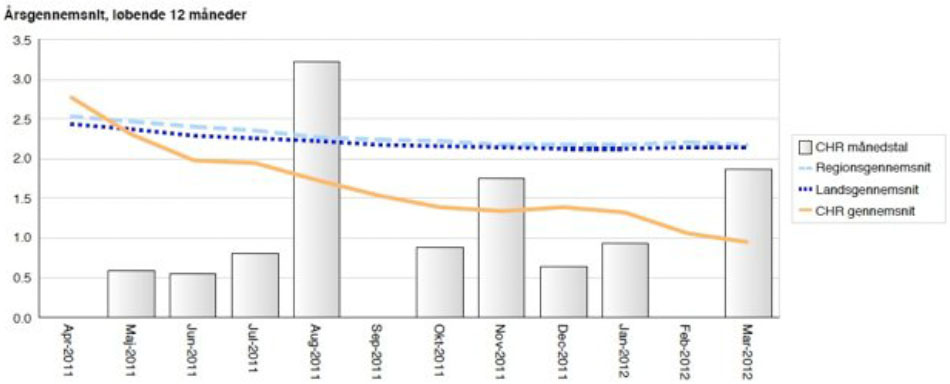
Graph showing antibiotic use in the sow breeding house of Pilegaarden Farm, for the 12 months following the conversion from GM soy to non-GM soy in the food supply. The columns show the accumulated daily doses per 100 animals receiving medication in the breeding area on the farm. The dashed light blue line shows the 12-month running regional average. The dark blue dotted line shows the 12-month running national average. The orange line shows the 12-month running average of antibiotic prescribing (units of medication) in the Pilegaarden sow breeding house. This has now dropped to less than 50% of the national and regional average usage.
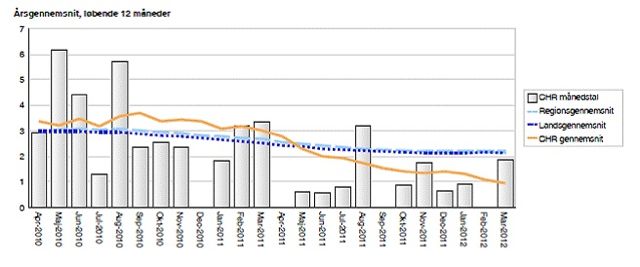
Extended curve, for a 24-month period. This curve has the same parameters, but shows how the medication units used in the sow breeding house were running above the national and regional averages prior to April 2011 – in the period when GM soy was used in the diet and when there were problems with bloat in sows and piglet diarrhoea.
His total extra costs are equivalent to 28,500 DKr. for 450 sows, or 63.34 DKr. per sow.
Putting the positive and negative cost factors together, the farmer concludes: "The savings in medicine alone pay for the extra cost incurred by the purchase of non-GMO soya. In total, I am looking at an increased profit of 250,000 DKr. or 550 kr. per sow. My animals are happier and healthier, and my profit margins have increased. So I must be doing something right!"
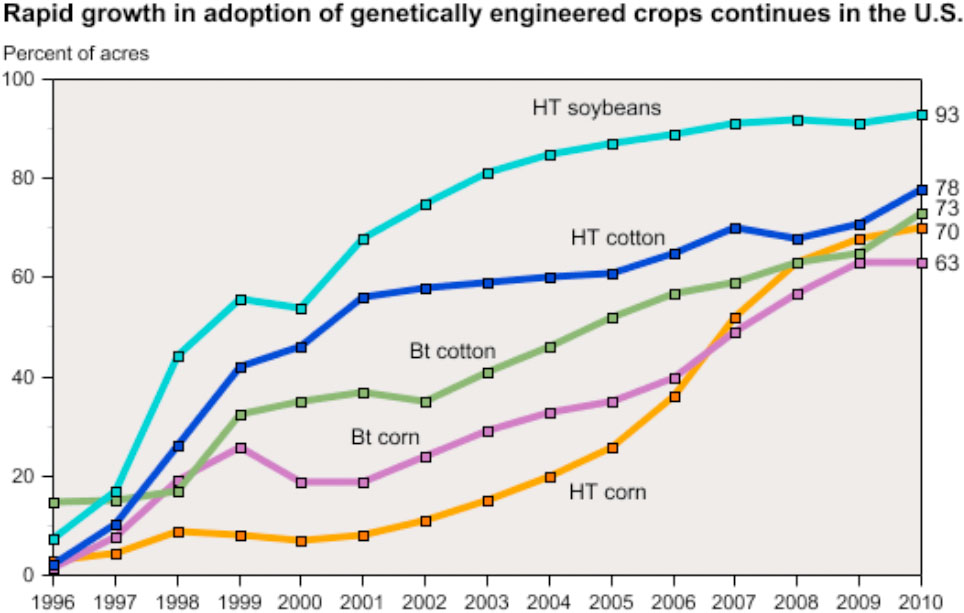
Data for each crop category include varieties with both HT and Bt (stacked) traits. Sources: 1996-1999 data are from Fernandez-Cornejo and McBride (2002). Data for 2000-10 are available in the ERS data product, Adoption of Genetically Engineered Crops in the U.S., tables 1-3.
The Situation Elsewhere
Between 32 and 36 million tonnes of soy is imported into Europe every year (mostly from Brazil, Argentina and USA) for use in the animal feed supply chain. Most of that is GM soy – only about 7 million tonnes per year are classified as non-GM. The biggest importers of GM soy are France, Germany, and Spain, but Denmark is heavily dependent upon GM soy beans and meal imported from Argentina. We understand that about 1.7 million tonnes of processed GM soy for animal feed was imported into Denmark in 2011.
We have picked up on substantial evidence of health problems, stillbirths and malformed foetuses in pig farming operations in countries other than Denmark where GMO soy is used in feed supplies. Sadly, much of this evidence is anecdotal and it is not recorded properly in the peer-reviewed literature. There is, not to put too fine a point on it, a cover-up within the farming industry. This is an outrage, and research worldwide should be directed immediately at this question of cause and effect relating to pig herd health and GM soy. In the words of an American colleague: "To my knowledge I am afraid that there will not be records kept by any official entity or agency in the USA on this subject. Because of the lie of GMOs being "substantially equivalent" and "generally recognized as safe" (GRAS), there were very few people looking for a problem when GM soy was first introduced on a large scale into animal diets, and when one developed most people simply referred to it as "a new norm". I know of several individual cases where problems were anecdotally demonstrated with GMO corn and soy products, but the records were all from farming operations and not from official entities. To my knowledge these instances started in 1997."
To their eternal shame, the GM industry, the farming unions and the US regulators have conspired together to ensure that it has become effectively impossible to undertake proper research in the American pig farming industry into the effects of GM soy feedstuffs; it is not too late for such research to be undertaken in Denmark and other EU countries, as a matter of urgency. This is not simply an animal welfare issue; the health of European consumers is at stake too. We should not need to remind anybody that human beings have digestive systems that are very similar to those of Mr Pedersen's pigs.
Note: It is not our intention here to do anything to harm the Danish pig industry, which is of great importance in the economy of Europe. As indicated above, Denmark has a very highly regulated industry, including a lower use of medication in pig herds than in most other EU countries. Strict sanctions are applied to pig farmers if medication use rises above an agreed threshold. Indeed, it is because of this tight regulation, with a long tradition of openness and transparency, and the requirements for record keeping and veterinary surveillance, that Mr Pedersen has been able to assemble his information in the form described above. This would have been impossible in most EU countries. Denmark is to be congratulated in this respect, and it is our hope that if Mr Pedersen's experiences are replicated elsewhere, and if the industry takes action on the issue of GM soy, and improves the health of the national pig herd as a consequence, the country will obtain a strong competitive advantage in the market place.
Part 2: Assessment of the Danish Press Coverage
Pig farmer reaps gains from GMO-free soy
http://www.effektivtlandbrug.dk/indhold/sider/artikler/vis_artikel.aspx?id=2426i

The journal EFFEKTIVT LANDBRUG published a front page piece on 13 April 2012 which appears to have caused quite a stir in Danish farming circles. The main headline article was written by Anne Wolfenberg and Jacob Lund-Larsen, and it briefly described the "significant improvements" which farmer lb Borup Pedersen has seen in his herd after changing from GM-soy feed to GM-free soy. He was quoted as saying: "Most obvious was the fact that our massive problems with piglet diarrhoea disappeared from day one following the change." The journalists reported that after switching to GM-free soy, the farmer noted a number of improvements – including easier farrowing, sows with higher milk yield, fewer dead piglets, more uniform pigs at weaning, lower medication use, a higher farrowing rate and an increase in weaned pigs per pen, with many litters of 14 piglets.
The journalists reported that the many improvements in the health of the herd were – in cash terms – more than enough to cover the cost of the more expensive GM-free feed. The farmer was reported as saying: "The savings that I have accomplished in the medicine account have already paid for the extra cost of the GM-free soya."
The article reported that Mr Pedersen is also critical of GM soya because it is grown with a significant use of glyphosate on the fields. On that basis, he said he is convinced that his colleagues would drop GM forage crops if they were better informed about the harmful effects which hey have on animals and humans.
The article reported that the Danish Center for Pig Research has just decided to test the gastrointestinal health of pigs that are fed with GMO and non-GM soy.
On the front page of the paper, there was a Sidebar Feature with the heading: "A Frightening Possibility?" and posing this question: "Are the use of GMO-crops and Roundup equally fatal for animals and humans, and are DDT and Thalidomide really only minor problems compared to GMO and Glyphosate?"
This question was explored on page 2 of the newspaper, in what was presumably an Editorial comment. The writer noted that there are many frightening prospects that come up in the wake of reading the story on the front page about farmer lb Borup Pedersen, who wished to make other Danish farmers aware of the apparently harmful effects of GM crops and glyphosate. "There may be those who will regard this pig producer in today's paper as a dangerous village idiot or fanatic," said the writer. "Regardless of the hype which is attached to him, the facts are that he (the farmer) as a layman has put a huge amount of time and energy into personal contacts with experts and researchers all over the world, in order to get to the bottom of this matter. Therefore, one can also simply call him a soul burning with desire." The reader was invited to judge for himself what Mr Pedersen's motives may be. The writer said that the big questions are these: "Is the pig farmer correct in the conclusions he draws from his experience? Is the use of GM crops and glyphosate fatal to animals and humans, and are DDT and thalidomide really only trifles compared to GM and glyphosate? Or is he horribly mistaken?"
–but what if there is some truth in the claims about health damage to animals fed on GMO feedstuffs? It was pointed out that it is very difficult nowadays to obtain GMO free soya such as that used by the pig producer mentioned in the articles. So what, asked the writer, can the other Danish farmers do, not to mention farmers across the rest of Europe, and those in the U.S.A.? This, thought the writer of the piece, would mean creating a whole new world order on the soya bean front, before GM free supplies could be guaranteed.
The writer of the article said that many different labels could be put on a man who has the courage to come forward with such controversial findings, where others may have conflicting interests. However, it was noted that this ordinary farmer had managed, just two months ago, to get the top agricultural professionals into a meeting, as a consequence of which the Pig Research Centre announced that an experiment designed to test the effects of GMO and Non-GMO soya will be launched this autumn.
The newspaper congratulated the Pig Research Centre for initiating this new study so quickly, in a field that can have such serious consequences, with the proviso that sometimes more haste leads to more work in the long run. "Nobody can of course be best served," said the writer, "if a subject with such menacing perspectives is not explored in depth with quality methods. The least that Danish pig producers, however, may reasonably ask, is that their money is not wasted on a single pro forma trial for the sole purpose of being able to say that they were"doing something." On that basis the writer of the piece wished the researchers well with improved design and greater security in the setup of their experiment, which has thus far been described only in outline terms.
The Main Article
On pages 6 and 7 of the newspaper, there was a double spread feature article called "Pig Focus: GMO-free soya gave a boost in production, by Anne Wolfenberg. In deference to her, we will not reproduce, translate or try to summarise that article here, but the published Danish version is readily available on request. On the whole, it is less detailed that the summary published (with the kind assistance of Mr Pedersen himself) in Part One of this Dossier, above.
Part 3: New Research Project Does GMO soy compromise pig's health?
http://vsp.lf.dk/Aktuelt/Nyheder/2012/04/020412.aspx
VSP (The Danish Pig Research Centre) is testing for the effects of non-GMO soy and GMO-based soybean on pig finishers. Statements indicate that GM soy may have an effect on the pig's stomach health. The uncertainty will now be addressed in a study in pigs.
2 April 2012 Press Release
GM soybeans have been approved in the EU system and are considered to be safe to use as feed for livestock. Certain experiences, especially from the United States, however, suggest that in some herds there are health problems which can be attributed to the use of GMO soybean meal. Several observations related to GMO use have been made in the USA, but there still no clear scientific evidence that GM soy is a real risk.
Statements from the USA suggest that the use of GM soya treated with glyphosate can have a negative effect on pigs' stomach health. "The uncertainty prompts us to undertake this study, for the sake of the animals. By following and comparing 100 pigs receiving feed containing GMOs with 100 pigs given non-GMsoya, we expect to get an indication on whether it is the soy type that affects stomach health,"says Niels Jorgen Kjeldsen, Head of the Centre for Pig Production.
The VSP study is planned to map the stomach changes in Danish pigs, and it has launched a series of investigations designed to clarify how the stomach changes in swine can be reduced. With the current knowledge, gastrointestinal changes can be reduced but not eliminated. It is therefore interesting to elucidate how the use ofGM soy compared with non-GMO soy may have an effect on gastric lesions in pigs.
On VSP's experimental station Gronhoj 100 pigs have been allocated feed consisting of standard feed containing GMsoya and corn, which may also be treated with glyphosate. These piglets are then compared with wopigs given feed containing non-GMO soya and cereals, which has not been treated with glyphosate. The pigs are fed from 30 kg bodyweight to slaughter at ca. 110 kg. The stomachs are then assessed for changes attributable to the feed.
The trial will begin in the latter half of 2012.
Comment from GM-Free Cymru: We are aware that the Danish research team, operating within very tight financial constraints, wishes to commence and conclude this research as rapidly as possible, in view of the great public interest already aroused. However, we are very concerned that the study is not starting at 28 days (approx 7 kg animal weight), since it is quite possible – and indeed likely – that during the weight gain period between 7 kg and 30 kg bodyweight, toxic effects will be triggered off by the use of GMO feed in both groups of animals. That would distort the findings when the animals are killed and examined – possibly leading to charges that the experimental protocols have been "fixed." We also gather that in the experiments the control group of animals will be the 100 pigs fed on the GM soy diet; if the intention of the experiment is to look for chronic toxic effects, that seems to us to be scientifically perverse.
There are other questions too, which we would like the Danish research team to consider.
(a) Are they going to use antibiotics during this feeding study? These could mask effects with the researchers purport to be looking for.
(b) If they do not begin the study from weaning at c 28 days, what feed stuffs will they use in the preliminary feeding period? If GM material is included in the ration, the results will be compromised.
(c) What will the ration be for the sows that the pigs are farrowed from? The experimental results could be biased in one direction or another if all of the sows are fed GM soy, or indeed if they are all fed on non-GM soy.
(d) What will be the male / female balance in the two groups? Again this could influence the test results.
(e) Can the researchers guarantee that the non-GM soy used for one group of animals will not have been contaminated with glyphosate residues? We recommend that it should be ORGANIC non-GM soy.
There are other questions as well, but these are for scientists and farmers who are expert in the field. But we appreciate the fact that by "going public" with this research proposal, the Danish research team is effectively inviting specialist comments and advice.
Part 4: Mr Pedersen is not alone
Since preparing this Dossier we have spoken with another Danish farmer, Sigurd Christensen, who farms at Burkal in southern Jylland. He farms with both dairy cattle and pigs. He told us that prior to his use of GM soy in the feed for the cattle herd, he experienced hardly any cattle deaths; but he said that when GM soya came into the diet around 2007 the death rate in his milking herd gradually rose to the point where last year ten cows (10% of milkers) died. The causes of these deaths were difficult to determine, but four months ago, he vaccinated his animals and then moved to the use of non-GM soy in the diet in at attempt to resolve the problem. Since then there have been no deaths, and medication costs for the cattle herd have dropped dramatically. In his pig herd of 500 sows, Mr Christensen reported that he had a history of major problems with sow health and piglet diarrhoea, and again decided to shift to the use of non-GMO soy in December 2011. It is still early days, but he has already noticed an improvement in the health of his pig herd, a reduction in reproductive problems, and a fall in medication use. Productivity has risen from 27 piglets per sow per year to 33.7 – well above the national average.
We wonder how many other farmers there are in Denmark (and indeed in the other EU countries) who have similar experiences with GM soy animal feed, ailments in pig and cattle herds, use of antibiotics, and stillbirths and live piglet malformations? Are they numbered in hundreds? Thousands? We have spoken to another pig farmer (in the UK) and he tells us that farmers are notoriously secretive when it comes to such matters, since they are in a competitive industry, and since nobody wants to admit to problems. Veterinary officers, who certainly know what is going on, tend to abide by a code of confidentiality. Record keeping at a regional and national level is inadequate in many EU countries, and there seems to be no central collation of statistics which will allow proper "cause and effect" investigations to be undertaken with respect to GM soy animal feed. We hope that we will be proved wrong on this, and that Government Departments of Agriculture do indeed know what is going on down on the farm – there are animal welfare and human health issues at stake too.
But our pig farmer contact also tells us that farmers are very pragmatic. Their priorities have always been – and always will be – to produce food at a price which the market can bear, as efficiently as possible, with the lowest possible negative impacts on animals and the environment, and with the best possible returns on investment. On that basis, we hope that the experiences of Mr Pedersen and Mr Christensen will alert thousands of other farmers to the fact that their ongoing use of a potentially harmful product (namely GM soy animal feed) has animal welfare implications, causes health problems that have to be addressed, and – perhaps most important of all from their point of view – damages profitability.
DOWNLOAD A PDF OF THE DOSSIER HERE.
NOTES
The evidence of environmental and health harm arising from the cultivation and use of GM soy has been accumulating for more than a decade. Key research findings have repeatedly been brought to the attention of EFSA and the EC, but they have repeatedly been ignored. At the same time the GM industry apologists have systematically attempted to discredit all those who have conducted experiments which have linked animal health damage with GM crops such as herbicide-tolerant GM soy.
Further information can be found via the following links:
http://www.gmwatch.eu/images/pdf/Carrasco_research_paper.pdf
http://www.reduas.fcm.unc.edu.ar/report-from-the-first-national-meeting-of-physicians-in-the-crop-sprayed-towns
http://www.gmfreecymru.org/documents/cheap.html
Letter to EU Member States concerning the vote on genetically engineered soybean 40-3-2 (Monsanto) and A5547-127 (Bayer CropScience) 9.11.2011 Christoph Then, Testbiotech Steffi Ober, Naturschutzbund (NABU), http://www.testbiotech.de/en/node/573
http://www.eureporter.co/2011/10/roundup-and-birth-de
http://www.gmfreecymru.org/pivotal_papers/ermakova.htm
Antoniou M, Habib M, Howard CV, Jennings RC, Leifert C, Nodari RO, Robinson C, Fagan J. Roundup and birth defects: Is the public being kept in the dark? Earth Open Source, 2011.
http://www.scribd.com/doc/57277946/RoundupandBirthDefectsv5
GM SOY – Sustainable? Responsible? by Michael Antoniou, Paulo Brack, Andres Carrasco, John Fagan, Mohamed Habib, Paulo Kageyama, Carlo Leifert, Rubens Onofre Nodari, Walter Pengue 2010 GLS Gemeinschaftsbank eG and ARGE Gentechnik-frei
http://www.gmwatch.eu/reports/12479-reports-reports
http://www.gmfreecymru.org.uk/pivotal_papers/rottweiler.htm
http://www.gmfreecymru.org.uk/pivotal_papers/crucial4.htm
ISIS Report 06/10/10 Argentina's Roundup Human Tragedy Ten years of GM soy and glyphosate poisoning have escalated the rates of cancer and birth defects. Claire Robinson http://www.i-sis.org.uk/argentinasRoundupHumanTragedy.php
We apologize for any inaccuracies that occur in this dossier because of the problems of translating from one language into another. This is not a scientific dossier; it is a report of Mr Pedersen's findings on his own farm, with an attempt to put these into context and to draw some significance from them. We leave it to others to conduct a scientific debate. We acknowledge the great assistance given to us in interviews by Mr Pedersen and Mr Christensen. We will appreciate comments and corrections, which can be submitted via the GM-Free Cymru web site: http://www.gmfreecymru.org/
Published by GM-Free Cymru on April 27th 2012, with the kind cooperation of Mr lb Borup Pedersen. This material is freely available for use under the normal terms of the Creative Commons license, but in case of reproduction, acknowledgement will be appreciated.
GM-Free Cymru (Wales) 27th April 2012










